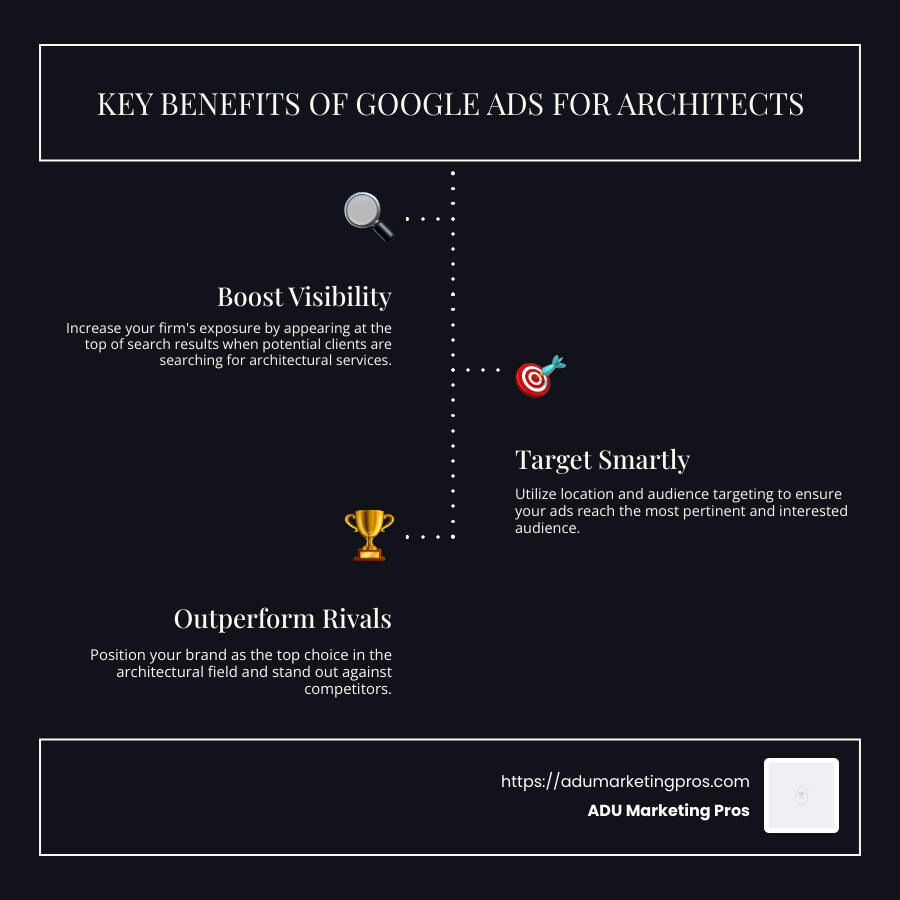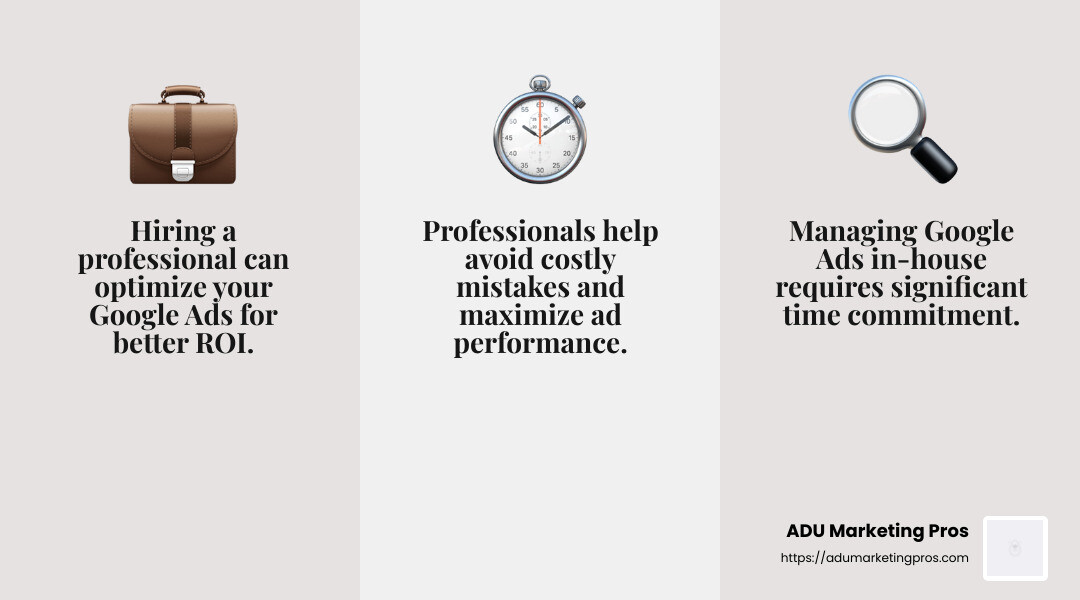Google Ads for architects is a game-changer for firms eyeing digital growth in today’s competitive landscape. In a nutshell, it connects your architectural vision with those seeking it, precisely when they are searching.
Here’s what you need to know right away:
- Boost Visibility: Get in front of homeowners, developers, and businesses searching for your services.
- Target Smartly: Hone in on specific locations and audiences, ensuring your ads reach the most interested eyes.
- Outperform Rivals: Lift your brand above the rest and be the first choice in your niche.
For architecture firms, embracing Google Ads isn’t just about placing ads—it’s about leveraging a powerful tool to build a strong, recognizable presence online. This strategy not only amplifies the reach of your creative genius across Los Angeles and beyond but also attracts a steady stream of high-quality leads. Whether you’re an ADU innovator like Ava, looking to create stunning accessory dwelling units, or a large-scale firm expanding into new territories, Google Ads can channel your efforts precisely where they count.
As competition rises and the architectural marketing landscape evolves, one thing remains clear: the digital arena is the next frontier for architects aiming to expand their influence and clientele.

Quick Google Ads for architects terms:
– Facebook ads for architects
– Lead generation for architects
– Online marketing for architects
Why Google Ads for Architects?
Google Ads offers architects a unique opportunity to connect with potential clients actively searching for architectural services. By leveraging target audience, location targeting, and keyword targeting, architects can maximize their reach and impact.
Target Audience
Architects can use Google Ads to tailor their campaigns to specific demographics. Whether you’re targeting homeowners interested in modern design or businesses seeking sustainable architecture, Google Ads allows you to zero in on those most likely to engage with your services. This precision ensures that your marketing efforts aren’t wasted on uninterested parties, increasing the likelihood of conversion.
Location Targeting
Location targeting is crucial for architects who operate in specific areas. With Google Ads, you can focus your campaigns on particular cities, neighborhoods, or even a defined radius around your office. For instance, if your firm is based in Los Angeles, you can target ads to appear specifically to users in that region or exclude areas where you don’t offer services. This ensures that your ads reach the right people in the right places, maximizing your advertising spend.

Keyword Targeting
Keyword targeting allows architects to reach potential clients based on their search queries. By selecting relevant keywords, such as “modern home design” or “commercial building architects,” you ensure your ads appear to users actively seeking those services. Google Ads offers different match types—broad, phrase, and exact—that give you control over how closely a user’s search must match your chosen keywords.
For example, using an exact match for a term like [sustainable home design] ensures that your ad is shown only to users searching for that specific phrase. This approach can drive highly qualified traffic to your website, increasing the chances of conversion.

Google Ads for architects is not just about being seen—it’s about being seen by the right people at the right time. By focusing on these key areas, you can effectively improve your firm’s visibility and attract more clients who are ready to invest in your expertise.
Setting Up Your Google Ads Campaign
Before diving into the creative aspects of your campaign, lay a solid foundation. This involves setting up your Google Ads account, structuring your campaign, and defining clear objectives. Let’s break it down.
Account Creation
To get started with Google Ads for architects, head over to ads.google.com and create an account. The setup process is straightforward:
-
Business Information: Enter your firm’s name, address, and contact details. This helps local clients find you easily.
-
Billing Information: Add a payment method to cover your ad spend. You’ll be billed monthly based on your daily budget settings.
-
Initial Campaign Setup: Google often prompts you to create a basic campaign during setup. Don’t stress about perfection here—focus on getting the basics right, and you can fine-tune later.
Campaign Structure
A well-organized campaign structure is crucial for effective management and optimization. Here’s how you can set it up:
-
Campaigns: Think of campaigns as overarching themes. For architects, you might have separate campaigns for “Residential Projects,” “Commercial Projects,” and “Sustainable Architecture.”
-
Ad Groups: Within each campaign, create tightly themed ad groups. For example, under “Residential Projects,” you might have ad groups like “Modern Home Design” and “Home Renovations.” This helps maintain relevance and improve ad quality scores.
-
Keywords: Add keywords related to each ad group’s theme. Use phrase and exact match types initially to target specific search queries. For instance, in the “Modern Home Design” ad group, you could use keywords like “modern house architects” or [contemporary home designers].
Campaign Objective
Choosing the right objective is key to achieving your advertising goals. For most architectural firms, the primary aim is to generate leads. By selecting the Leads objective, you can encourage potential clients to take actions like filling out a contact form or calling your office.
-
Conversion Tracking: Set up conversion tracking to monitor how many leads your ads generate. This provides valuable insights into your campaign’s effectiveness and helps you make data-driven decisions.
-
Performance Metrics: Regularly review metrics such as click-through rates (CTR) and conversion rates. These indicators will show you how well your ads are performing and where improvements are needed.
By establishing a robust Google Ads campaign from the start, you’ll be well-positioned to attract the right clients and grow your architectural firm. Next, we’ll explore best practices for optimizing your ads and landing pages to maximize conversions.
Google Ads for Architects: Best Practices
Now that you’ve set up your Google Ads account and structured your campaigns, it’s time to focus on best practices. These will help you get the most out of your advertising efforts.
Keyword Selection
Selecting the right keywords is crucial for reaching your ideal audience. Begin by brainstorming terms that potential clients might use when searching for architectural services. For instance, if you specialize in residential projects, consider using keywords like “custom home design” or “best residential architects near me.”
Don’t stop at basic keywords. Incorporate long-tail keywords to capture more specific searches. For example, “affordable residential architects in Louisville” can help you target clients in specific locations and with specific needs.
A good rule of thumb is to use 80 to 120 keywords, mixing generic terms with long-tail, local, and branded keywords. This variety will help you reach a broader audience while still targeting the right people.
Ad Groups
Organizing your keywords into ad groups is essential for creating relevant and effective ads. Each ad group should focus on a specific theme or service you offer.
- Example: If you have a campaign for “Residential Projects,” create ad groups like “Modern Home Design,” “Sustainable Architecture,” and “Home Renovations.”
Within each ad group, include keywords that are closely related to the theme. This ensures that your ads are highly relevant to users’ searches, improving your ad quality score and potentially lowering costs.
Landing Page Optimization
Your landing page plays a crucial role in converting ad clicks into potential clients. Here are some tips for optimizing your landing page:
-
Relevance: Ensure the landing page content matches the ad copy. If someone clicks on an ad for “Modern Home Design,” they should be taken to a page that highlights your modern design projects.
-
Call to Action (CTA): Include a clear and compelling CTA. Whether it’s a contact form or a phone number, make it easy for visitors to take the next step.
-
Speed and Mobile-Friendliness: Your landing page should load quickly and be optimized for mobile devices. Many users will access your site from their phones, so a mobile-friendly design is essential.
By focusing on these best practices, you’ll be well on your way to running successful Google Ads for architects. Next, we’ll discuss how to budget and monitor your campaigns to ensure you’re getting a good return on investment.
Budgeting and Monitoring
Once your Google Ads campaigns are set up and optimized, it’s crucial to manage your budget smartly and keep a close eye on performance metrics. This ensures that your advertising dollars are working effectively for you.
Budget Setting
Setting a budget is the first step in controlling your ad spend. Start by determining how much you’re willing to spend each month. Small architectural firms often start with a budget between $100 and $10,000 monthly.
-
Initial Budget: Begin with a smaller budget to test different strategies. A starting point could be around $500 per month. This allows you to gather data on what works without overspending.
-
Adjust as Needed: As you collect performance data, adjust your budget. Increase spending on successful campaigns and reduce it on underperforming ones.
Performance Metrics
Monitoring performance metrics is vital for understanding the effectiveness of your campaigns. Key metrics to track include:
-
Click-Through Rate (CTR): A higher CTR means your ads are relevant and engaging. The average CTR across industries is about 3.17%. Aim for at least this benchmark.
-
Conversion Rate: This measures how many clicks lead to desired actions, such as filling out a contact form. A good conversion rate indicates that your landing page is effective.
-
Return on Ad Spend (ROAS): Calculate how much revenue you earn for every dollar spent on ads. A positive ROAS means your campaigns are profitable.

Return on Investment
The goal of your Google Ads campaigns is to achieve a high return on investment (ROI). Here are some tips to maximize ROI:
-
Focus on High-Value Campaigns: Allocate more budget to campaigns that generate high-value leads. If a campaign consistently brings in clients who spend more, it deserves more funding.
-
A/B Testing: Continuously test different ad variations to see which performs best. This can include changing headlines, images, or calls to action.
-
Optimize for Quality: High-quality ads and landing pages improve your quality score, which can lower costs and improve ad positions.
By carefully setting your budget and monitoring performance metrics, you can ensure that your Google Ads for architects are driving valuable results. Next, we’ll address some frequently asked questions about Google Ads for architects.
Frequently Asked Questions about Google Ads for Architects
Does Google Ads work for architects?
Absolutely! Google Ads for architects can be a game-changer. It offers architects instant visibility and the ability to reach potential clients actively searching for architectural services. Unlike organic methods, such as SEO, which can take months to show results, Google Ads provides immediate exposure.
Architects can also benefit from targeted advertising. This means your ads are shown to people in specific locations, at certain times, and even to particular demographics. This precision ensures your marketing efforts reach those most likely to need your services.
Moreover, integrating Google Ads with platforms like Facebook and Instagram can further improve your digital marketing strategy. These social platforms are excellent for showcasing your projects visually, while Google Ads drives traffic and potential clients directly to your website.
How much should architects spend on Google Ads?
The amount architects should spend on Google Ads depends on several factors, including their sales goals and the competitiveness of their market.
-
Sales Goals: Define your objectives. Are you aiming to increase brand awareness, generate leads, or boost project inquiries? Clear goals will guide your budget decisions.
-
Cost-Per-Click (CPC): Understand the average CPC for your targeted keywords. This will help you estimate how much each click will cost and how it fits into your budget.
A good starting point is to allocate around $500 to $1,000 per month. This budget allows you to test the waters, gather data, and adjust strategies without overspending. As you see what works, you can scale your budget to maximize successful campaigns.
Should architects do Google Ads themselves or hire a professional?
The decision to manage Google Ads in-house or hire a professional boils down to two main factors: time vs. money.
-
Time: Running Google Ads effectively requires time and expertise. It involves setting up campaigns, selecting keywords, creating compelling ad copy, and continuously monitoring and optimizing performance. If you or your team have the time and willingness to learn, managing it yourself could be feasible.
-
Money: Hiring a professional can be more expensive upfront, but it often leads to better results. Professionals have the expertise to optimize campaigns for the best return on investment. They can save you time and help avoid costly mistakes.
In many cases, architects find that outsourcing to a specialized digital marketing agency like ADU Marketing Pros can be beneficial. This allows you to focus on what you do best—designing remarkable spaces—while experts handle your advertising efforts.

By understanding the nuances of Google Ads and making informed decisions, architects can significantly improve their online presence and attract more clients. Let’s dive deeper into how ADU Marketing Pros can provide specialized solutions for measurable growth.
Conclusion
In the competitive world of architecture, standing out requires more than just exceptional design skills. It demands a strategic approach to digital marketing, and that’s where ADU Marketing Pros steps in. We specialize in crafting custom marketing solutions that empower architectural firms to attract high-quality leads and grow their revenue.
Our approach centers on specialized solutions designed specifically for the unique challenges faced by ADU construction and architecture firms. By focusing on expertise rather than price, we ensure that your firm becomes the obvious choice for clients who value quality over cost-cutting.
Our services include targeted SEO, PPC, and social media strategies that highlight your firm’s strengths and project your expertise to a wider audience. For instance, by leveraging Google Ads for architects, we can help you reach potential clients at the exact moment they’re searching for architectural services. This precision targeting not only drives traffic but also increases the likelihood of conversion, ensuring a better return on your advertising investment.
Moreover, at ADU Marketing Pros, we believe in measurable growth. Our data-driven approach means that every campaign is carefully monitored and optimized for performance. We provide clear metrics and insights, so you can see the tangible impact of your marketing efforts and make informed decisions about future strategies.
Ready to lift your firm’s online presence and attract the clients you deserve? Learn more about our specialized digital marketing strategies for ADU construction and architecture firms.
By partnering with ADU Marketing Pros, you’re not just investing in marketing—you’re investing in the future of your firm. Let us help you design a path to success.



